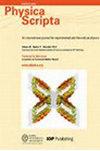Correcting the effect of temperature changes in the measurement results of dielectric response in power transformers as an arrhenius type dielectric with the help of artificial neural network
IF 2.6
3区 物理与天体物理
Q2 PHYSICS, MULTIDISCIPLINARY
引用次数: 0
Abstract
Polarization and Depolarization Current (PDC) and Frequency Domain Spectroscopy (FDS) measurements are common dielectric response tests in time and frequency domain that are widely used to diagnosis insulation status in power transformer companies. Numerous factors affect the PDC and FDS test results, which the most important of them is temperature variation. To accurately interpret the results of the dielectric response, the effect of temperature on the results in time and frequency domains, must be corrected. In this paper, firstly a 200 MVA transformer is selected as a test object and FDS and PDC tests are performed on it at different temperatures. Then, based on the FDS results performed on a transformer at different temperatures, the parameters of the insulation model have been estimated by using genetic algorithm (GA). Next, with the help of artificial neural network (ANN), the parameters of the insulation model, related to the different temperatures are transferred into the reference parameters. After that, the parameters of the transferred insulation model, the FDS curves are plotted and transferred to the reference temperature curve and the effect of temperature on them is compensated. By using the correlation of the time and frequency domain results, with the help of transferred insulation model parameters, the PDC results are also plotted and transmitted on the reference PDC curve. Finally, with such a method, the effect of temperature on the PDC results is compensated.借助人工神经网络修正温度变化对作为阿伦尼乌斯型介质的电力变压器介电响应测量结果的影响
极化和去极化电流(PDC)和频域光谱(FDS)测量是常见的时域和频域介电响应测试,广泛用于电力变压器公司的绝缘状态诊断。影响 PDC 和 FDS 测试结果的因素很多,其中最重要的是温度变化。为了准确解释介电响应结果,必须修正温度对时域和频域结果的影响。本文首先选择了一个 200 MVA 变压器作为测试对象,并在不同温度下对其进行了 FDS 和 PDC 测试。然后,根据变压器在不同温度下的 FDS 结果,使用遗传算法(GA)估算绝缘模型的参数。然后,在人工神经网络(ANN)的帮助下,将与不同温度相关的绝缘模型参数转移到参考参数中。然后,将转移后的绝缘模型参数、FDS 曲线绘制并转移到参考温度曲线上,并补偿温度对它们的影响。通过时域和频域结果的相关性,在转移的绝缘模型参数的帮助下,PDC 结果也被绘制并传输到参考 PDC 曲线上。最后,利用这种方法可以补偿温度对 PDC 结果的影响。
本文章由计算机程序翻译,如有差异,请以英文原文为准。
求助全文
约1分钟内获得全文
求助全文
来源期刊

Physica Scripta
物理-物理:综合
CiteScore
3.70
自引率
3.40%
发文量
782
审稿时长
4.5 months
期刊介绍:
Physica Scripta is an international journal for original research in any branch of experimental and theoretical physics. Articles will be considered in any of the following topics, and interdisciplinary topics involving physics are also welcomed:
-Atomic, molecular and optical physics-
Plasma physics-
Condensed matter physics-
Mathematical physics-
Astrophysics-
High energy physics-
Nuclear physics-
Nonlinear physics.
The journal aims to increase the visibility and accessibility of research to the wider physical sciences community. Articles on topics of broad interest are encouraged and submissions in more specialist fields should endeavour to include reference to the wider context of their research in the introduction.
 求助内容:
求助内容: 应助结果提醒方式:
应助结果提醒方式:


